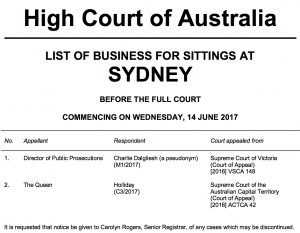The High Court has dismissed two appeals against a decision of the Full Federal Court on restrictive trade practices law and the location of markets, specifically the meaning of a market ‘in Australia’. Section 4E of the Competition and Consumer Act 2010 (Cth) provides that for the purposes of the Act ‘market’ means, absent a contrary intention, a ‘market in Australia’. The ACCC brought proceedings against the two appellant airlines, who are both involved in transporting cargo from other countries into Australia, claiming that the airlines had engaged in collusive behaviour by fixing surcharges and fees on air cargo arriving into Australia from Hong Kong, Singapore and Indonesia. The airlines claimed that the markets for that cargo were located in the departure nations, not Australia, and thus the provisions of the Act did not apply to their dealings there. The primary judge agreed with the airlines, holding that the markets were located in those countries because they were where the decision to choose an airline to carry freight into Australia took effect (the ‘switching decision’), and that decision was made when the Continue reading
Daily Archives: 14 June 2017
Hughes v The Queen
The High Court has dismissed an appeal against a decision of the New South Wales Court of Criminal Appeal on tendency evidence in the context of multiple child sexual offences. The appellant, a well-known actor in a 1980s television series, was convicted of nine child sexual offences and sentenced to 10 years and nine months imprisonment. Among the evidence at trial was evidence from a range of complainants and other witnesses on the appellant’s sexual interactions with them, which was said to establish a tendency of the appellant to act in a particular way or have a particular state of mind, specifically, holding a sexual interest in children, using his social, familial and employment relationships to gain access to them, and engaging in particular kinds of sexual conduct. The NSWCCA dismissed his appeal against the conviction and sentence, rejecting (among a number of other arguments) that the trial judge erred in allowing the tendency Continue reading
News: High Court hears appeal in…. Sydney??
This may not seem like news, but it is a first in nearly four decades. While the High Court’s Sydney Registry is often host to hearings of Australia’s apex court, these have long been limited to minor fare: special leave hearings, case management and the like, involving between one and three judges. By contrast, today’s hearings involve the Court’s core business (appeals) and at least five judges, something that last happened in Sydney on 10th and 11th March 1980, when all seven members of the Barwick Court heard a workers compensation dispute.
What changed after that date? The opening of the High Court’s first and only dedicated premises in May 1980 in Canberra. While Sir Garfield wanted that move to mark an end to the Court’s ‘circuits’ of Australian capitals (then administered by its Sydney Registry), a combination of resistance from the other judges (who didn’t want to live in Canberra) and state bars preserved the circuit system, albeit in a more limited form described in the Court’s most recent annual report as follows:
The Court conducts its sittings in Canberra and such other places as are determined by a Rule of Court made by the Justices in the preceding year. In addition, applications for special leave to appeal to the Court are heard regularly in Sydney and Melbourne, and the Court continues the practice, established on its inauguration, of sitting in Brisbane, Adelaide, Perth and Hobart if warranted by the amount of business.
So, what has changed now? Continue reading
